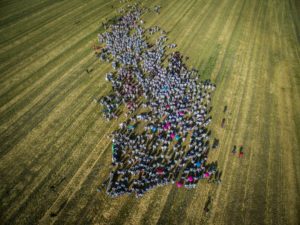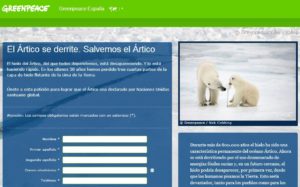Greenpeace Switzerland’s website traffic has increased 30-fold since they began using began using Google Grants, a free advertising program for non-profits, in September 2012. MobLab sat down with the office’s digital communications team to ask them how they pulled it off.
“We used the largest part of our [advertising credit] to send traffic to our site and it worked extremely well,” says Steff Kerkhof, Webmaster at Greenpeace Switzerland (GP Switzerland).
Starting with only a few hundred visitors per month in September 2012, GP Switzerland optimized its key words and text ads to help bring more than 30,000-50,000 monthly unique visitors to its website.
Google Grants is the nonprofit edition of AdWords, Google’s online advertising tool. It gives nonprofit organizations up to $10,000 (USD) per month of AdWords credit. The advertising credit provides a tremendous opportunity for non-profits to generate traffic to their homepages and to convert visitors to supporters.
“It makes a lot of sense to use Google Grants,” says Steff. “We can drive a lot of traffic to our site.”
GP Switzerland worked with Semiotic Media to set up its Google Grants campaigns. But Steff says you can use the easy-to-navigate Google AdWords Toolbar to create ads without hiring an outside firm. (NOTE: Google recently replaced the AdWords Toolbar with Keyword Planner.)
Using testing to boost conversions
In addition to driving traffic to raise awareness of its work, GP Switzerland wanted to achieve conversions to increase its supporter engagement.
Turning visitors into supporters has been a challenge. GP Switzerland is still far from its goal of getting 5 per cent of visitors to make a donation, take an online action like signing a petition or signing up for a newsletter, or downloading a brochure.
“We are trying to improve on those numbers by improving the campaigns themselves and also by coming up with new landing pages,” says Steff.
To achieve better results, GP Switzerland is interpreting the tracking and analytics provided by AdWords. Based on this information, they are experimenting with alternative landing pages.
The landing page is where traffic is sent after clicking an ad. The Google Grants program requires that participating non-profits direct all traffic to the official website they registered with but it is possible to use subdomains as alternate landing pages.
Steff’s team recently decided to create landing pages for a campaign calling for clean, safe, and renewable energy and for another campaign demanding toxic-free fashion and clean water.
For each campaign, they will test layouts for different segments of GP Switzerland’s online audience. Each page will explain the issue, how the campaign seeks to solve the problem, and how people can support the campaign. They are hopeful that these customized pages will lead to higher conversion rates.
“No matter what business you are in, it will not be successful right away. That’s just never going to happen,” says Steff. “I think, in general, that’s a message for AdWords. Improving campaigns takes time.”
Tips for optimizing performance: Focus on size and reach, click rates and landing pages
Semiotic Media shared three pieces of advice for non-profits that want to get the most out of Google Grants.
- Optimize the size and reach of your campaign: When you post new content to your website, grow the size of the campaign by adding more AdWords keywords to your campaign. If your supporters do not all speak the same language, consider designing ads in additional languages to reach everyone in your target audience.
- Optimize your text click-rates: You can significantly improve text click rates by testing different versions of your ads. Write several versions, run each one, and compare the results.
- Optimize your landing pages: You will notice a close connection between the quality of your landing page and your ad performance, including conversion rates. To optimize landing pages, use A/B testing, a simple way to test changes to a page against the current design. This technique allows you to determine which one produces the highest conversion rate.
1. Google offers nonprofit product offerings that are available in select countries. This reference chart displays offerings available in your country.
Categories:
tech, tools and tactics



